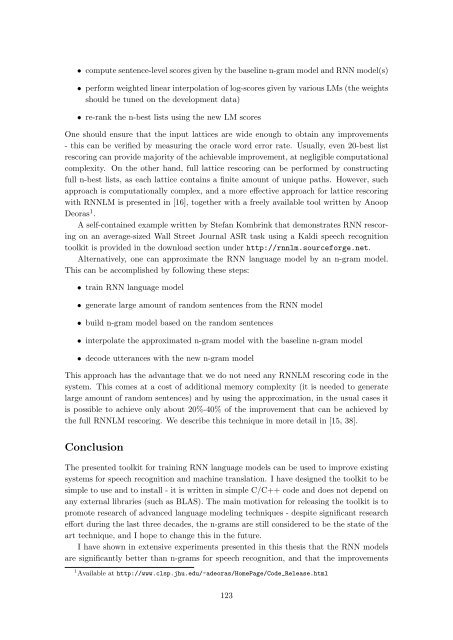Statistical Language Models based on Neural Networks - Faculty of ...
Statistical Language Models based on Neural Networks - Faculty of ...
Statistical Language Models based on Neural Networks - Faculty of ...
You also want an ePaper? Increase the reach of your titles
YUMPU automatically turns print PDFs into web optimized ePapers that Google loves.
• compute sentence-level scores given by the baseline n-gram model and RNN model(s)<br />
• perform weighted linear interpolati<strong>on</strong> <strong>of</strong> log-scores given by various LMs (the weights<br />
should be tuned <strong>on</strong> the development data)<br />
• re-rank the n-best lists using the new LM scores<br />
One should ensure that the input lattices are wide enough to obtain any improvements<br />
- this can be verified by measuring the oracle word error rate. Usually, even 20-best list<br />
rescoring can provide majority <strong>of</strong> the achievable improvement, at negligible computati<strong>on</strong>al<br />
complexity. On the other hand, full lattice rescoring can be performed by c<strong>on</strong>structing<br />
full n-best lists, as each lattice c<strong>on</strong>tains a finite amount <strong>of</strong> unique paths. However, such<br />
approach is computati<strong>on</strong>ally complex, and a more effective approach for lattice rescoring<br />
with RNNLM is presented in [16], together with a freely available tool written by Anoop<br />
Deoras 1 .<br />
A self-c<strong>on</strong>tained example written by Stefan Kombrink that dem<strong>on</strong>strates RNN rescoring<br />
<strong>on</strong> an average-sized Wall Street Journal ASR task using a Kaldi speech recogniti<strong>on</strong><br />
toolkit is provided in the download secti<strong>on</strong> under http://rnnlm.sourceforge.net.<br />
Alternatively, <strong>on</strong>e can approximate the RNN language model by an n-gram model.<br />
This can be accomplished by following these steps:<br />
• train RNN language model<br />
• generate large amount <strong>of</strong> random sentences from the RNN model<br />
• build n-gram model <str<strong>on</strong>g>based</str<strong>on</strong>g> <strong>on</strong> the random sentences<br />
• interpolate the approximated n-gram model with the baseline n-gram model<br />
• decode utterances with the new n-gram model<br />
This approach has the advantage that we do not need any RNNLM rescoring code in the<br />
system. This comes at a cost <strong>of</strong> additi<strong>on</strong>al memory complexity (it is needed to generate<br />
large amount <strong>of</strong> random sentences) and by using the approximati<strong>on</strong>, in the usual cases it<br />
is possible to achieve <strong>on</strong>ly about 20%-40% <strong>of</strong> the improvement that can be achieved by<br />
the full RNNLM rescoring. We describe this technique in more detail in [15, 38].<br />
C<strong>on</strong>clusi<strong>on</strong><br />
The presented toolkit for training RNN language models can be used to improve existing<br />
systems for speech recogniti<strong>on</strong> and machine translati<strong>on</strong>. I have designed the toolkit to be<br />
simple to use and to install - it is written in simple C/C++ code and does not depend <strong>on</strong><br />
any external libraries (such as BLAS). The main motivati<strong>on</strong> for releasing the toolkit is to<br />
promote research <strong>of</strong> advanced language modeling techniques - despite significant research<br />
effort during the last three decades, the n-grams are still c<strong>on</strong>sidered to be the state <strong>of</strong> the<br />
art technique, and I hope to change this in the future.<br />
I have shown in extensive experiments presented in this thesis that the RNN models<br />
are significantly better than n-grams for speech recogniti<strong>on</strong>, and that the improvements<br />
1 Available at http://www.clsp.jhu.edu/~adeoras/HomePage/Code_Release.html<br />
123







